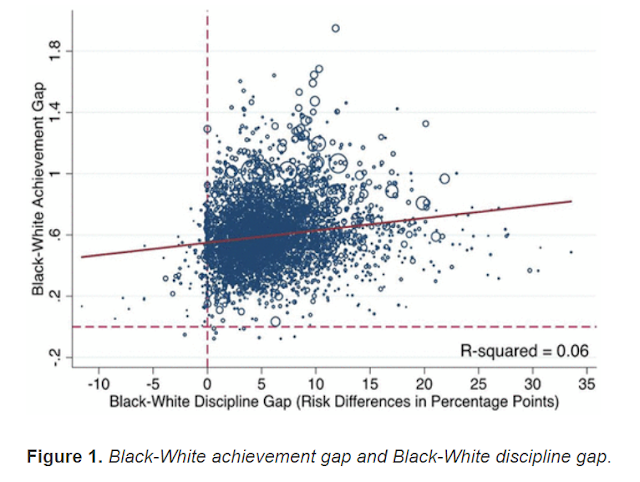The Problem of Being a Black Child in the United States
Racism has not been completely extinguished in our lives. Racist structures may have been dismantled but our underlying biases that invigorate racism remain strong. The achievement gap between black and white children in our schools lingers. Enrollment of black children in advanced academic programs continues to be low. Our partiality is clearly underscored in the fact that black children are more likely than white students to be suspended. In fact, recent research shows that the black-white achievement gap profoundly correlates with a black-white discipline gap.
The above graph should bring to mind a profound sadness. Almost all the points lie above the zero-line of the y-axis, black-white achievement gap. In this national survey which includes 2000 school districts across the country, one is considerably hard-pressed to spot a school where black children outperform white children. Similarly, there are also very few schools where white students are disciplined more than black students. The correlation between these two gaps survives even after correcting for other factors, such as school poverty, racial composition of schools, and disparities in special education and gifted programs. Therefore, the correlation is universally true.
There is likewise a graph for Hispanic children.
Although the achievement gap exists in most schools between Hispanics and Whites, one striking difference here is that there are a lot of schools that do not discipline Hispanic children disproportionately compared to White children. And the correlation seen here between achievement and discipline gaps can be explained by the other factors such as socio-economic status.
By examining further the relationship between suspension rates and achievement for various races, one does not see a negative correlation for White students. Being more likely to be disciplined does not automatically translate to poorer academic performance in the case of White students. The relationship, however, remains robust for Black children. The discipline and achievement gaps for Hispanics, on the other hand, are related to confounding factors like poverty and school resources. Clearly, we can address White-Hispanic gaps by making our schools more equitable. Addressing White-Black gaps requires, however, so much more, for we continue to hold onto our racist thoughts.
 |
| Above copied from Pearman, F. A., Curran, F. C., Fisher, B., & Gardella, J. (2019). Are Achievement Gaps Related to Discipline Gaps? Evidence From National Data. AERA Open. https://doi.org/10.1177/2332858419875440 |
The above graph should bring to mind a profound sadness. Almost all the points lie above the zero-line of the y-axis, black-white achievement gap. In this national survey which includes 2000 school districts across the country, one is considerably hard-pressed to spot a school where black children outperform white children. Similarly, there are also very few schools where white students are disciplined more than black students. The correlation between these two gaps survives even after correcting for other factors, such as school poverty, racial composition of schools, and disparities in special education and gifted programs. Therefore, the correlation is universally true.
There is likewise a graph for Hispanic children.
 |
| Above copied from Pearman, F. A., Curran, F. C., Fisher, B., & Gardella, J. (2019). Are Achievement Gaps Related to Discipline Gaps? Evidence From National Data. AERA Open. https://doi.org/10.1177/2332858419875440 |
Although the achievement gap exists in most schools between Hispanics and Whites, one striking difference here is that there are a lot of schools that do not discipline Hispanic children disproportionately compared to White children. And the correlation seen here between achievement and discipline gaps can be explained by the other factors such as socio-economic status.
By examining further the relationship between suspension rates and achievement for various races, one does not see a negative correlation for White students. Being more likely to be disciplined does not automatically translate to poorer academic performance in the case of White students. The relationship, however, remains robust for Black children. The discipline and achievement gaps for Hispanics, on the other hand, are related to confounding factors like poverty and school resources. Clearly, we can address White-Hispanic gaps by making our schools more equitable. Addressing White-Black gaps requires, however, so much more, for we continue to hold onto our racist thoughts.
Comments
Post a Comment